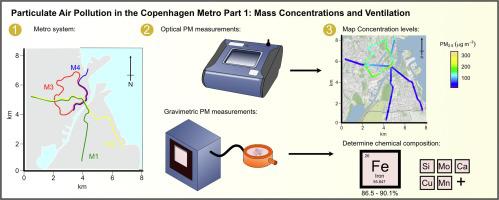Environment International ( IF 11.8 ) Pub Date : 2022-11-08 , DOI: 10.1016/j.envint.2022.107621 Niklas Kappelt 1 , Hugo S Russell 2 , Dafni Fessa 3 , Keith Van Ryswyk 4 , Ole Hertel 5 , Matthew S Johnson 1

|
The Copenhagen Metro comprises four lines, the M1, M2, M3 and M4, with 25 subterranean stations and an additional 14 stations above ground, serving ca. 80 million passengers annually. In this study we measure fine particulate matter (PM2.5) and carbon dioxide (CO2) concentrations in stations and in trains across the entire system. In partially underground lines, high PM2.5 concentrations with an average of 109 μg m−3 are found in below-ground stations. The observed correlation between PM2.5 concentration and distance between a station and a tunnel exit is attributed to ventilation via the piston effect. The piston effect via tunnel draught relief shafts was therefore found to be relatively limited. Filter samples of particulate matter are analysed using particle-induced X-ray emission and show an iron content of 88.6 % by mass which is quite different from above-ground particulate matter and consistent with particle production by train wheels, rails and brakes. The average concentration measured at the stations of a recently opened (2019) fully underground M3 closed loop line is 168 μg m−3, further demonstrating that while piston effect-driven ventilation is effective in close proximity to tunnel openings, it is relatively limited via tunnel draught relief shafts. Measurements onboard trains show even higher PM2.5 concentrations and the patterns in CO2 concentrations suggest carriage ventilation by tunnel air. Ventilation via doors during platform stops caused a drop in observed PM (and CO2) at stations, but the system is surprisingly polluted despite its recent construction. CO2 mixing ratios ranged from ambient to around 600 ppm. Measures should be taken to control PM levels using a combination of source control and increased clean air supply of the Copenhagen and other similar metro systems.
中文翻译:

哥本哈根地铁中的颗粒物空气污染第 1 部分:质量浓度和通风
哥本哈根地铁包括 4 条线路,M1、M2、M3 和 M4,有 25 个地下车站和另外 14 个地上车站,服务于约 每年8000万人次。在这项研究中,我们测量了整个系统中车站和火车中的细颗粒物 (PM 2.5 ) 和二氧化碳 (CO 2 ) 浓度。在部分地下线路中,地下站发现了平均 109 μg m −3的高 PM 2.5浓度。观察到的 PM 2.5之间的相关性车站和隧道出口之间的浓度和距离归因于活塞效应的通风。因此,发现通过隧道通风安全井的活塞效应相对有限。使用颗粒诱导的 X 射线发射分析过滤颗粒物样品,结果显示铁含量为 88.6%(按质量计),这与地面上的颗粒物有很大不同,与火车车轮、铁轨和制动器产生的颗粒物一致。在最近开通的(2019 年)全地下 M3 闭环线路的站点测得的平均浓度为 168 μg m −3,进一步表明,虽然活塞效应驱动的通风在靠近隧道开口处有效,但通过隧道通风井相对有限。列车上的测量显示 PM 2.5浓度更高,CO 2浓度模式表明车厢通风采用隧道空气。站台停靠期间通过门通风导致站内观察到的 PM(和 CO 2 )下降,但尽管该系统是最近建造的,但出人意料地受到了污染。CO 2混合比范围从环境到大约600 ppm。应采取措施控制 PM 水平,结合使用源头控制和增加哥本哈根和其他类似地铁系统的清洁空气供应。



























 京公网安备 11010802027423号
京公网安备 11010802027423号